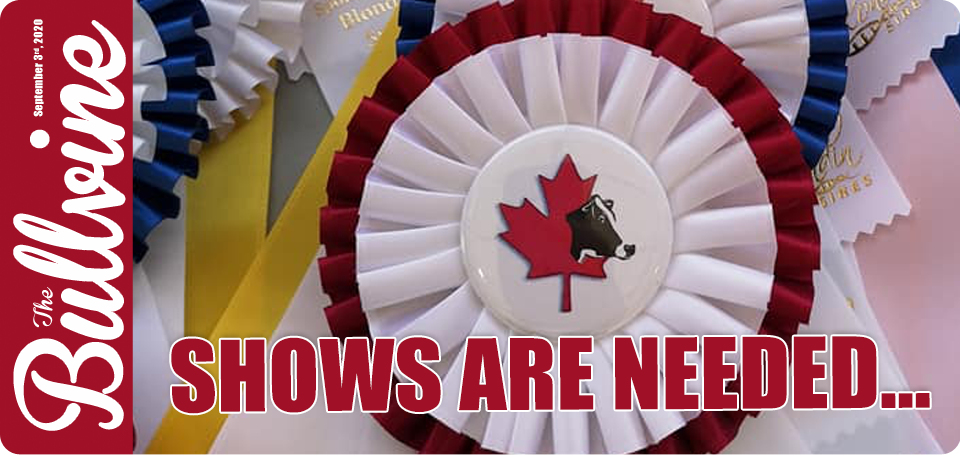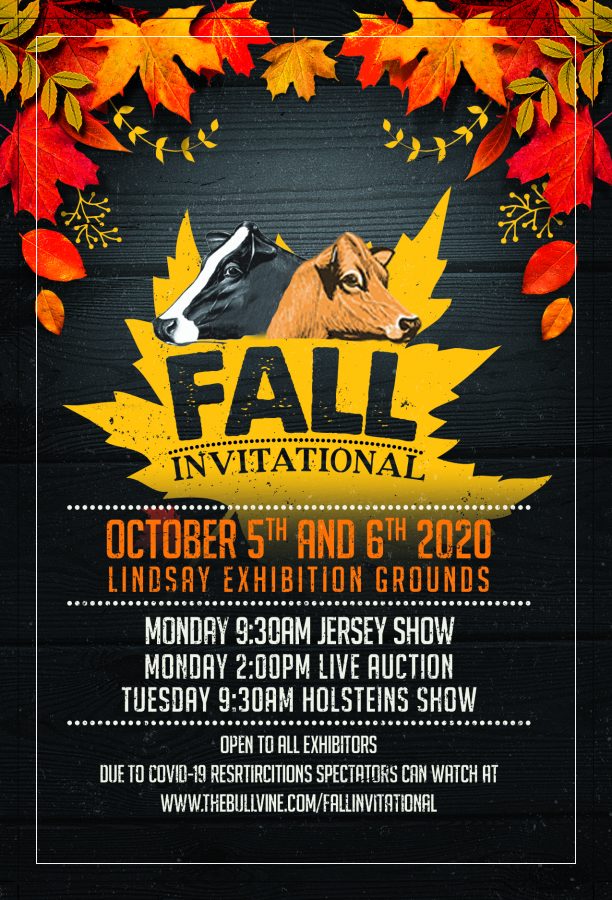When Barclay Phoenix put his shoulder to the wheel to initiate a show in Canada, the people who knew him well recognised the look in his eye.
He was determined to make it happen, and they didn’t doubt that he would.
Most breeders in the USA have been able to continue to show this year because of different COVID protocols. The rest of the world has watched from the sidelines with more than a twinge of envy.
And, Barclay felt strongly that Canada needed to get some urgent airtime if it was going to sustain its energy and profile within global cattle marketing.
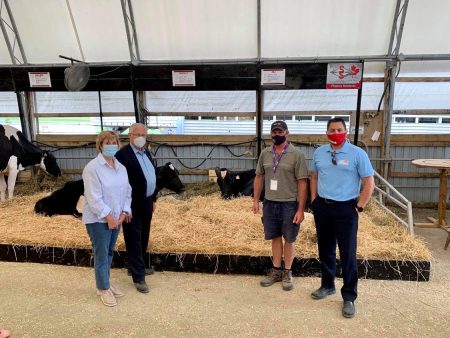
Two days before the show the minister of Agriculture and the local politicians attended the show to make a big announcement for funding for agriculture societies.
His solution was to get on the phone to health officials, prominent breeders and The Bullvine. It was a mission many have talked about, and none had progressed past the brainstorming and the hurdles at that point.
However, this time within 2.5 weeks of navigating strict health regulations, and other challenges, Barclay and his wife, Shelley, pulled off an important precedent for the Canadian industry.
The Summer Invitational 2020 goes down as the first profile show to be held in Canada this year, and the highest-profile show on the world stage so far this year. It happened at the Lindsay Exhibition Grounds in Ontario under judge Brent Walker. It was an invitational because government restrictions limited it to 100 people, in addition, to show staff on-ground. There were 150 entries. (See full show report here)
While the public couldn’t visit to watch, the extreme focus on the calibre of exhibitors, pre-show interviews, and online streaming were the game-changers.
There were 5000 Youtube Livestream views on The Bullvine on show day and 10,000 views in the first two days. In all, 55,000 people have seen coverage on The Bullvine alone. To put the publicity into perspective, it comes in just after World Dairy Expo and the Royal as the third most-watched show, and is 5 times as many viewers than live streams during this COVID time on other media outlets. And, it puts it well ahead of most others shows, which have sub-50,000 viewers.
(Due to internet challenges during the show a clean recorded version of the show is now available)
“To say this show achieved more coverage than most of the big US shows during these COVID times – as a first-time show with an incredibly short lead-in time – is almost insane,” The Bullvine’s Andrew Hunt said.
Dianna Malcolm talks to Barclay, Shelley, Andrew and one of the king-hitter exhibitors, Ferme Jacobs, about why the show worked, and what is in the pipeline going forward…
DM: “Barclay and Shelley, thanks for your time today. Lots of people have talked about starting shows this season, but no-one outside of the regional shows in the US has got it done yet. What made you want to pull this off?”
BARCLAY: “Well, this is our business up here as far as merchandising cattle and we haven’t had an opportunity to do it this year, particularly in Canada. And, it was a little frustrating in that you can see shows going on in the US, and I just decided around June 1 that I’d like to try and create a show. After listening to the radio and hearing that the regulations had changed, I first called the local health officials, before they even knew the changes. I then called Jacobs (Ferme Jacobs), Pierre Boulet, Simone Lalande (Ferme Blondin), Kingsway, and some others and given them the heads up that we’re were going to have a show, and that I was 85% sure it would happen. Two weeks before the cattle got there, we didn’t even have more than 50 people allowed on the grounds. Then I called to get the health guy out to the showgrounds, and a week before the cows moved in, we were cleared to have 100 people involved, and 60 staff.”
ANDREW: “Knowing that Barclay had taken the time to get everything in place gave me a lot of confidence that he was going to make it happen, and I decided I wanted to get involved rather than be left behind.”
DM: “What were the key ingredients to the Summer Invitational’s success?”
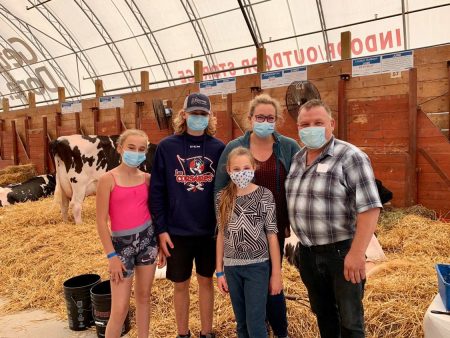
“It wasn’t held in downtown Toronto or downtown Victoria, but it was one hour from Toronto airport in the city of Lindsay, in the Kawartha Lakes region (population of just over 75,000). Everyone could walk to the hotel, and we could drive to McDonald’s and Tim Horton’s in five minutes. Those necessities are important to make everything go well.
“But, if it wasn’t for The Bullvine this wouldn’t have had the ripple effect across the world that it did within the short time-frames we were operating within to build hype.
“I said that by the time Friday came around I wanted the world to know that we’re having a show. And, I think by the time the cattle moved in there – with Shelley doing the interviews – that plan came together.”
[fbvideo link=”https://www.facebook.com/TheBullvine/videos/2945988235512029/” width=”900″ height=”600″ onlyvideo=”1″]
ANDREW: “I think that those video interviews made a big difference. And, you know, I’ve had so many people suggesting ideas about what should be done without the shows this year. But they have all been just ideas. It takes a helluva lot more to turn ideas into a show. The way this came together so quickly was through the determination, knowledge and effort from Barclay and Shelley.”
BARCLAY: “I didn’t even have anyone to line up the cattle an hour before judging started.”
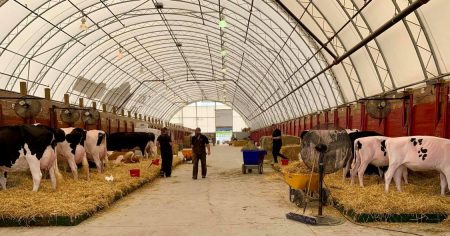
DM: “You also said there was a different feeling on the showgrounds?”
ANDREW: “Barclay and Shelley started a chat stream on Facebook, and all the exhibitors and sponsors were in that chat room. They got everyone talking.”
BARCLAY: “It was kind of neat because we’d put a comment or a request in there, and people responded. And, you could feel the excitement building from the exhibitors.
“I really enjoyed that chat group. The exhibitors were our show committee really. For instance, one day someone asked about wearing coloured shirts for judging. In Canada, we are known for wearing white shirts, and the response from everybody was that ‘It’s a Canadian show, and it’s our first show and we’d like to wear white shirts’, so, that was that. The exhibitors decided. And, on show day, we assembled cows outside to come into the ring, because we didn’t have to wear masks out there, but it got hot and sunny in that space, and I put the message into the chat room that people could go around to the shady side, and before you knew it everyone had moved over there. It was that easy. I think the chat room made everyone feel involved.”
ANDREW: “Plus, one of the neat things was that Barclay is never afraid to ask someone, do things differently, or to push things to a higher level.”
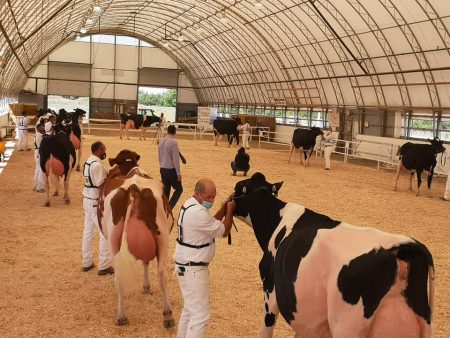
BARCLAY: “I think we achieved what we set out to do. If this show didn’t happen, and we were sitting here yesterday watching that show in Wisconsin, I think there would have been a lot of frustrated Canadians thinking, ‘Oh my God, we need a show’.
“It’s kind of set the stage a little bit and maybe we can springboard off this to get another one up and going. It’s too bad the US and Canada can’t get together, but that’s just the way it is this year. There was so much advertising coming out of this show, and that’s what we set out to achieve. Obviously, without social media we wouldn’t have got it done.”
ANDREW: “Barclay said we have to let the world know and he wanted to do the video interviews. And Shelley took that on, so full props to her.”
SHELLEY: “I’d rather be in the background, but things were happening so fast and there were so many things to do, that Barclay asked me to do it. And, he’s not an easy guy to say ‘no’ to. It was fun and interesting hearing from the breeders.”
BARCLAY: “We made a good team. And, everybody seemed to be in a good mood, and they were all smiling from what I could see.”
DM: “To get the feedback you had, must be heartening because by your own admission this show wasn’t without pressure. And, you couldn’t invite everyone simply because of the ceiling on numbers. Do you think there is a bit of regret from some of the exhibitors who were invited, but who didn’t/couldn’t join you?”
BARCLAY: “Absolutely. Because we knew that these exhibitors needed to get something out of this. And, in my opinion, they got huge advertising.
“And, I had a prominent fella in the business I hadn’t heard from in four- or five-months text me afterwards. The text said, ‘Congrats on pulling off what likely seemed impossible at certain moments, but we both know that it just adds fuel to your fire. Well done.’ That was nice to receive.”
SHELLEY: “People really helped each other out at the show too, if they needed something. We don’t always see that kind of collaboration between teams at a show. And, we couldn’t walk 20 feet without being thanked by people.”
ANDREW: “Barclay’s family also did a great job coming out to help. Half of the show staff had the last name ‘Phoenix’.
BARCLAY: “When I phoned my dad on the way home – and I was tired – I said to him that he should be pretty proud of his kids and grandkids, nephews and nieces…and he said [Barclay takes on the gravelly tones of his father], ‘Well, I’m glad you got through it, because you almost gave me another stroke. Don’t do this again’.”
DM: “Why are shows so important to this industry?”
BARCLAY: “Everybody can take all the pictures they want at home, but I think that a cow or a heifer in the ring with a ribbon or having somebody liking her means a lot more. And, those phone calls you get afterwards regarding sales and marketing is what it’s all about.
“The Junior Champion got sold just before the Junior Champion class. There was a couple of other heifers sold before the show. There have been enquiries and sales on young cows since the show. And, that’s what it’s all about, eh? We had a fantastic judge. Everybody has got their different opinions, but everyone knew they’d get a fair shake with Brent (Walker).”
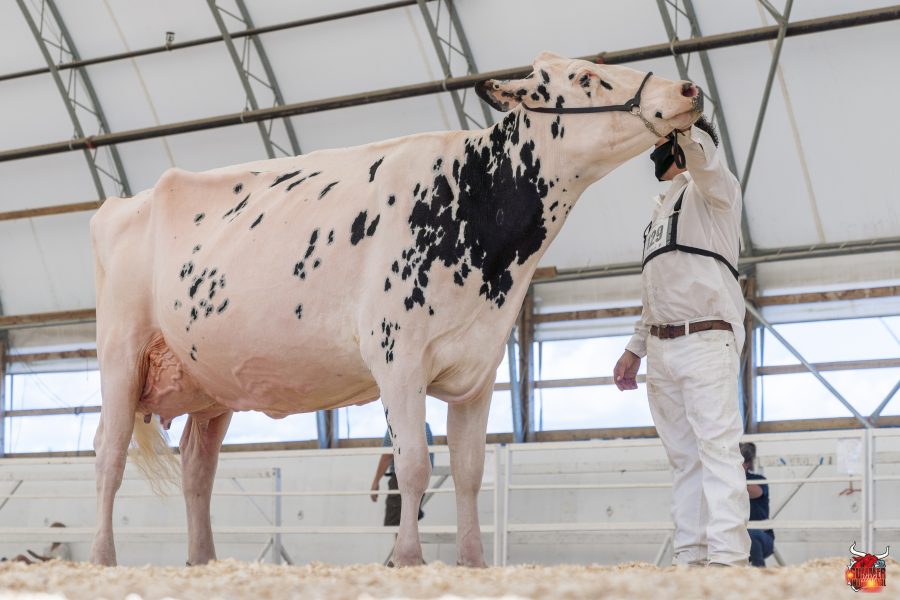
Grand Champion: Erbacres: Snapple Shakira-ET (Snapple), 1st 5-year-old, C & F Jacobs, Ferme Antelimarck 2001 Inc., Ferme Jacobs Inc., Kilian Theraulaz, Ty-D Holsteins, QC
DM: “Ysabel [Jacobs], we all know that with seven successive Premier Breeder banners at WDE, makes you the first call any prospective show committee will make. What made you decide to get on-board with eight head? Because the biggest players also have the most to lose if something like this doesn’t fly. Yet you didn’t hesitate to pony up. And, you came away with Grand Champion (Erbacres Snapple Shakira-ET, 1st 5-year-old), and Intermediate Champion (Jacobs High Octane Babe, 1st Senior 3-year-old).”
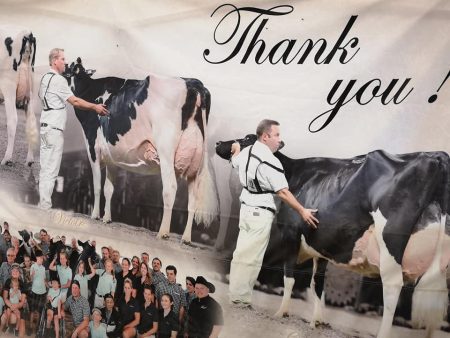
DM: “What were your reservations, if any?”
“We more hesitated at first because the cows were not ready, ready. But, in Canada every camping ground is open, every water park is open, so when you think about it, a showground is not worse than that.
“We need to learn how to live with the COVID virus. If anyone knows about viruses, it’s a farmer. We deal with them all the time. By respecting the protocol, we can make it happen. We just have to sometimes change location or do it smaller.
“When they announced the show and that there was a protocol already in place, we decided to do it.”
DM: “And, not just for yourselves, as I understand it?”
“For us this year, we have never sold as many embryos as right now. But it’s easy because of our last results. We are still on that high, and I’m sure it’s because people aren’t spending that much on travel etc, so they perhaps buy embryos.
“So, not having a show hasn’t affected us as much as others. But for some of the kids, who are developing young cows, I worry for them. Because they need those heifers and cows to get out to a show to be known. There are always new cows coming through and they need to be seen. I think we should just keep on doing the shows. Not international, but in each of our countries we need to make it happen – perhaps on a smaller scale until they find a solution for us.
“This show was awesome. Barclay and his team did a great job. From day one we felt very welcome. Everything went great, the facility was perfect, and while there were no spectators and less people, for me that was OK. With the number of views, The Bullvine had, we can’t ask for better than that.
“And, it’s important that it’s not just the competition, it’s also about the information you get around the show. We all talk about a lot of things when we all get together. We get updated on what’s going on. Without a show we don’t have the chance to talk with each other as much.
“And, when you have that passion, you need to keep that fire burning, and for us good cows are always going to bring people together. Also, our kids live for the shows. It is important to them, so that keeps us involved.”
DM: “I understand you sold a junior two (from your barn) and a senior two (from your show string) after the show to Elm Vue Holsteins?”
YSABEL: “Yes, and I’m sure the show helped to sell them.”
DM: “Barclay, swinging back to you, it seems that the industry perhaps now realises in moments of calamity like Covid-19, how vitally important to have the impact people, who are prepared to think outside the box, and make things happen for everyone. And, that includes the people prepared to get on-board, like your exhibitors?”
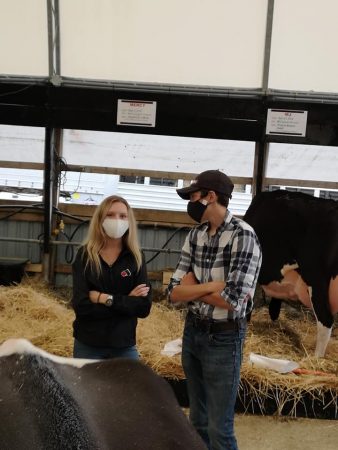
“And, when the elite exhibitors like Jacobs, Blondin, Pierre, and Kingsway, once they decided to come, that was the icing on the cake we needed to make this fly. For the next show, I need the boys from British Colombia to come.”
DM: “The next show? Do I hear the beginnings of another show?”
BARCLAY: “Yes, we are talking about it. It could be at the same spot, and it could be somewhat the same structure. Because of the weather – even though I’d love to have it at the same time as The Royal – it’s going to be too cold. I think at this point we’d be looking at the first or second week in October sometime. The reason for October is so the people from the West will be able to come down because I think they’re still talking about having their show at Red Deer.”
ANDREW: “I’ve been polling the exhibitors about whether they would attend the next show if there was one, and not a single one wouldn’t come back. I think everyone was there for the right reasons, and the Canadian industry badly needed this show.”
DM: “Is there anything else you’d like to add?”
BARCLAY: “I just want to take the opportunity to thank everyone for coming out. The aftermath, in general, has been incredible, to be honest. Overwhelming, actually.”

